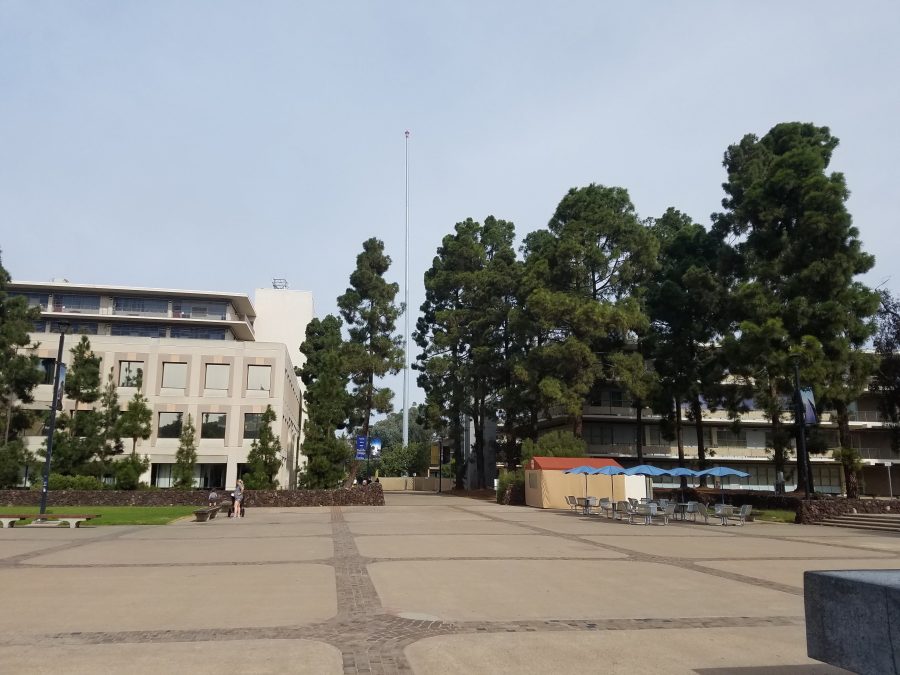The latest addition to UC San Diego’s Stuart Collection was revealed this past weekend and can now be found at the entrance to Roger Revelle College on Ridge Walk, near the university’s Main Gym. The installation, a 195-foot pole entitled What Hath God Wrought, signals the piece’s title in Morse code through the intermittent flashing of red lights from a lantern at the top.
The artist, Los Angeles–based Mark Bradford, drew inspiration from the first Morse code message to ever be sent in 1844. The message, which read “WHAT HATH GOD WROUGHT,” marked a critical turning point in the field of communication, eventually paving the way for modern virtual communication.
The pole has surpassed Building One in The Village at Torrey Pines in height by a margin of 2 feet, making it the tallest structure on campus.
Revelle College Council meeting notes from May 27, 2016 reveal that Bradford’s pole presented a challenge unprecedented in the history of the Stuart Collection: Because of the height of the piece, the design had to be approved by the Federal Aviation Administration before it could be implemented to ensure the safety of low-flying aircraft.
“We think it’s a very powerful message about the beginning of communication and [communication] as we know it today,” Stuart Collection director Mary Beebe wrote to the UCSD Guardian.
Funding for each addition to the Stuart Collection is privately raised by Beebe.
“I think about artists who we think could be interesting for the campus,” Beebe explained to the UCSD Guardian in an email. “Then I invite them to campus (we pay a proposal fee and expenses), and if they come up with an idea we think we like, we develop a proposal to submit to the Advisory Board. If they approve, we proceed with UCSD clearance (for site, safety, etc.) and the Chancellor has final approval.”
As senior philosophy major Sam Sprague noted, “The new installation reminds me of the minarets on the Hagia Sophia which, like this piece, were built for communication. But unlike minarets, which are used to call people to prayer, this tower repeatedly flashes the first message ever sent in Morse code, which seems appropriate for a STEM-centered school like UCSD.”
While the concept of What Hath God Wrought is generally lauded by some, others are critical of the aesthetics of the piece.
“The idea is cool, but the appearance of the pole is not totally artistic,” John Muir College senior Huinan Pang said. “Since the pole symbolizes the role of technology in the interconnectedness of the world, Revelle was an interesting placement choice. It feels a little like a warning to people trying to meddle with things that shouldn’t be meddled with.”
Others are concerned that the installation’s significance is overshadowed by its own appearance.
“While the concept is interesting, the installation itself is aesthetically bland and doesn’t offer anything very substantial to the campus,” Eleanor Roosevelt College senior Mekalyn Steve said. “ [It doesn’t] communicate its artistic purpose to most viewers who lack knowledge of its backstory.”
Former Provost of Revelle College Paul Yu shared his thoughts on the latest addition with Beebe.
“Among the fog…it looks as if it is reaching the sky and beyond,” Yu said.
What Hath God Wrought is the 20th addition to the Stuart Collection. The collection began in 1981, with the mission of preserving and growing UCSD’s outdoor sculpture collection. Notable pieces include Fallen Star, Snake Path, Two Running Violet V Forms (affectionately referred to by students as “giraffe catchers”), and the iconic Sun God statue.
photo by Tyler Faurot
This piece has been updated to correct the year the Stuart Art Collection began, as well as the exact height of the piece.














